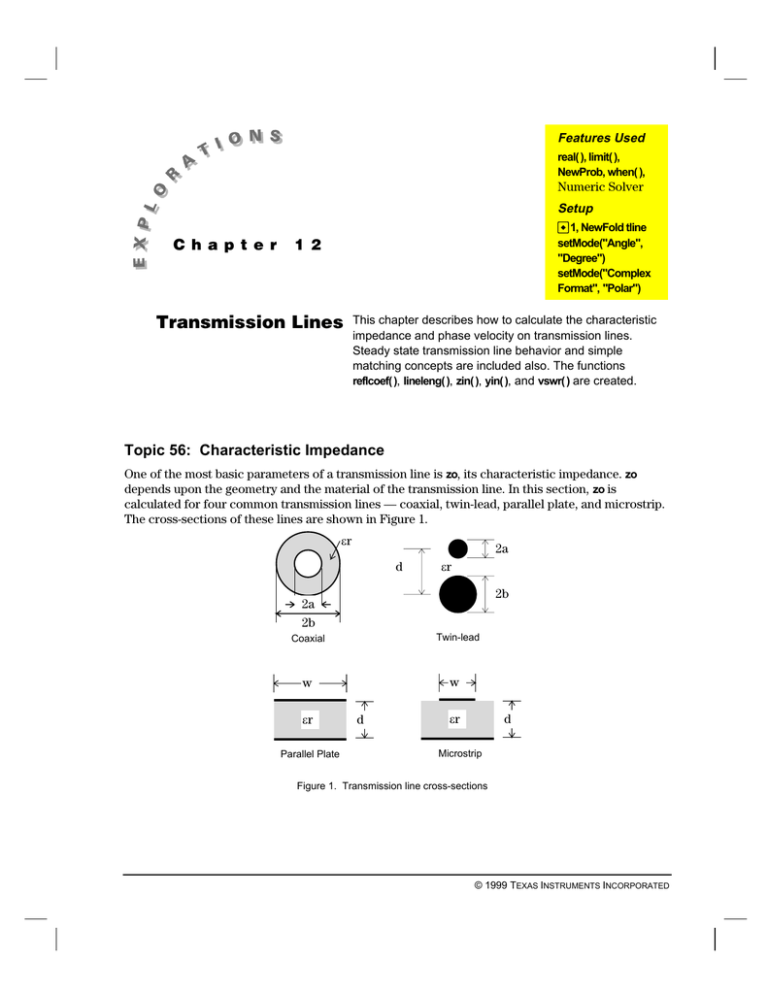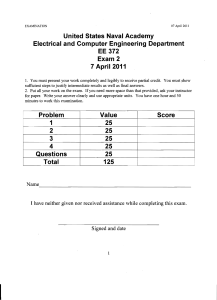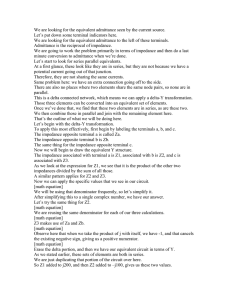Topic 56: Characteristic Impedance C h a p t e r 1 2
advertisement

Features Used real( ), limit( ), NewProb, when( ), Numeric Solver Setup ¥1, NewFold tline C h a p t e r setMode("Angle", "Degree") setMode("Complex Format", "Polar") 1 2 . Transmission Lines This chapter describes how to calculate the characteristic impedance and phase velocity on transmission lines. Steady state transmission line behavior and simple matching concepts are included also. The functions reflcoef( ), lineleng( ), zin( ), yin( ), and vswr( ) are created. Topic 56: Characteristic Impedance One of the most basic parameters of a transmission line is zo, its characteristic impedance. zo depends upon the geometry and the material of the transmission line. In this section, zo is calculated for four common transmission lines — coaxial, twin-lead, parallel plate, and microstrip. The cross-sections of these lines are shown in Figure 1. εr 2a d εr 2b 2a 2b Twin-lead Coaxial w w εr Parallel Plate d εr d Microstrip Figure 1. Transmission line cross-sections © 1999 TEXAS INSTRUMENTS INCORPORATED 118 ELECTRICAL ENGINEERING APPLICATIONS WITH THE TI-89 Coaxial zo = b 60ln a εr Twin-lead d 120 cosh −1 2 ab zo = εr Parallel Plate zo = Microstrip F= 120πd w εr εr + 1 + 2 εr − 1 2 1+ 12d w w/d≤1 w 8d 60 ln + 4d w zo = F w/d≥1 zo = 120π 2 w w F ln 1.444 + + 1.393 + d d 3 Table 1. Characteristic impedances The equations shown in Table 1 are used to calculate zo of a transmission line from its geometry and material parameters. However, with the TI-89’s numeric solver, any variable can be calculated when the others are known. Coaxial and Twin-lead 1. Clear the TI-89 by pressing 2 ˆ 2:NewProb ¸. 2. Press O 9:Numeric Solver to display the Numeric Solver, and enter the equation for zo as highlighted in screen 1. Note: To enter ε , press ¥ c j e. zocoax Á 60 p ½ ln( b e a d e c 2 ] ¥ c j er d d 3. Press ¸ or D to display the variables in the equation. (1) Note: The number of digits displayed is independent of the mode settings, since it is a numeric solution. © 1999 TEXAS INSTRUMENTS INCORPORATED CHAPTER 12: TRANSMISSION LINES 4. Enter values of b=.015, a=.005, and εr=2. Then move the cursor to zocoax= and press „ Solve to obtain the solution zocoax=46.61… Ω as shown in screen 2. The é symbols on the left side of the screen show which variable was calculated and that the solution is exact since left-rt=0. 5. 119 (2) To calculate the value of εr which will give zocoax=50, enter 50 into zocoax, move the cursor to εr, and press „ to display the required value of 1.73… (screen 3). (3) 6. In a similar manner, enter the zo equation for the twinlead line by moving to the top of the line. zotwin Á 120 p ½ cosh-1( d e c 2 p 2 ] a p b d d d e c 2 ] ¥ c j er d d 7. Set d=.01, a=b=.0005, and εr=1.5 and solve for zotwin=293.27… Ω (screen 4). 8. These two equations used can be accessed through ‡ ; the number of “last” equations is eleven (11) by default and is set using ¥ Í B (screen 5). (4) (5) 9. Press B to display both equations. Any equation in this list can be made the active equation by highlighting it and pressing ¸; activate zocoax (screen 6). (6) 10. Equations can be recalled to the Numeric Solver in this way as long as the number of last equations history is not exceeded. For more permanent storage, press ƒ 2:Save Copy As D. The equation is placed in the TLINE folder. Name it coax (if it is named zocoax, the equation name will conflict with the variable name) as shown in screen 7. (7) © 1999 TEXAS INSTRUMENTS INCORPORATED 120 ELECTRICAL ENGINEERING APPLICATIONS WITH THE TI-89 11. To verify that coax has been stored, press 2 ° and scroll down to the TLINE folder to see coax and each of the variables a, b, zocoax, and εr listed (screen 8). Since the variables are listed alphabetically and Roman characters precede Greek, εr is at the bottom of the folder; scroll down to see it. (8) Parallel Plate and Microstrip Although the remaining two equations can be entered into the Numeric Solver and saved in the same way, the rather complicated microstrip equation is entered and checked more easily in the Home screen. 1. Return to the Home screen, and clear the variables to be used in the microstrip equation as shown in screen 9. (9) ½ DelVar f b w b ¥ c j e r b d 2. Now enter the zo equation (screen 10). zomicro Á ½ when( w e d 2 Â Á 1 b 60 p 2 x 8 p d e w « w e c 4 d d d e f b 120 2 T e c c w e d « 1.393 « 2 e 3 p 2 x w e d « 1.444 d d p f d d § eqn (10) Note how the when( ) command is used to implement the two parts of the zomicro equation. The ! eqn at the end stores the zomicro equation so that the Numeric Solver uses it. 3. 4. Press O 9:Numeric Solver to see zomicro in the Numeric Solver. (11) So far f has not been defined. Return to the Home screen and define f as shown in screen 12. 2 ] c ¥ c j er « 1 d e 2 « c ¥ c j er | 1 d e c 2 p 2 ] 1 « 12 p d e w d d d §f To prevent deleting f with NewProb, be sure to lock it. Alternatively, name it ff. See Do This First. 5. (12) Display the Numeric Solver and press ¸. Enter the values for a microstrip transmission line on a dielectric substrate with thickness d=0.00127, εr=2.2, and a conductor width of w=.00391 m. Solving for zomicro gives zomicro=50.31…Ω (screen 13). (13) © 1999 TEXAS INSTRUMENTS INCORPORATED CHAPTER 12: TRANSMISSION LINES 121 Topic 57: Reflection Coefficient When sinusoidal generators are used to excite a transmission line, all transient waves have decayed to zero and the line is in steady state. A common steady-state design goal is to match the source impedance to the transmission line input impedance. The input impedance of a transmission line with characteristic impedance zo and length d is given by zin = zo 1 + ΓL e 1 − ΓL e − j4 π d λ − j4 π d λ for a frequency with a wavelength of λ. Since this calculation involves complex numbers, creating a function will make the calculations easier. 1. Clear the TI-89 by pressing 2 ˆ 2:NewProb ¸. 2. Calculate the reflection coefficient of the load impedance as ΓL = zl − zo zl + zo The reflection coefficient is a complex phasor with an amplitude of 1 or less. Define the function reflcoef as shown in screen 14. Note that limit( ) is used to handle the case of an open circuit with zl =∞. 3. (14) Return to the Home screen and use reflcoef to calculate the reflection coefficients for real loads of zl =50, 0, and ∞ Ω on a line with zo=50 Ω (screen 15). (15) 4. Calculate the coefficients for the complex load of 100ìj50 Ω on a line with zo=50 Ω (screen 16). 5. Press ¥ ‘ to get the floating point value shown at the bottom of screen 16. (16) The results are 0, -1, +1, and 0.45∠-26.57°. When the load is “matched” to the line, there is no reflected signal; a short circuit reflects the incident signal with opposite polarity; and an open circuit reflects with the same polarity. © 1999 TEXAS INSTRUMENTS INCORPORATED 122 ELECTRICAL ENGINEERING APPLICATIONS WITH THE TI-89 Topic 58: Phase Shift When the load is attached to the end of a length of line, the input reflection coefficient is multiplied by exp(-j4πd/λ) which is 1∠(-720d/λ) as a phasor in degree form. This term depends only on the line length in terms of wavelength d/λ. 1. Define the function lineleng as shown in screen 17. 2. Return to the Home screen and clear the TI-89 by pressing 2 ˆ 2:NewProb ¸. 3. Use lineleng to calculate the phase shift of a reflection coefficient for line lengths of d=0, 1/8, 1/4, and ½ wavelengths. Since the line length is given as a fraction of wavelength, λ=1 (screen 18). (17) Note: To enter λ, press ¥ c jL. To enter ∠, press 2 ’. To enter − , press ·. (18) Topic 59: Input Impedance/Admittance The equation for input impedance can be defined as a function. The input impedance depends upon the line length. For lines with d=nλ/2, the input impedance equals the load impedance. For loads with zl=zo, the input impedance is zo. 1. Press 3 and set Complex Format mode to RECTANGULAR. 2. Define the function zin as shown in screen 19. zin uses reflcoef from Topic 57 and lineleng from Topic 58. 3. Return to the Home screen, and clear the TI-89 by pressing 2 ˆ 2:NewProb ¸. 4. Use zin to calculate the input impedance of a line with zl =100-j50 Ω, zo=50 Ω, and λ=1. Use d=.35, d=.5, and d=1 (screen 20). (19) (20) 5. Calculate the input impedance for zl =50 Ω, zo=50 Ω, d=1, and λ=1. (21) Note: The Complex Format mode has been switched to Rectangular so that real and imaginary results are displayed. © 1999 TEXAS INSTRUMENTS INCORPORATED CHAPTER 12: TRANSMISSION LINES 6. 123 Since connecting elements in parallel with transmission lines is common, admittance is helpful in transmission line calculations. Define the admittance calculation as a function yin which uses the function zin (screen 22). (22) 7. Return to the Home screen, and clear the TI-89 by pressing 2 ˆ 2:NewProb ¸. 8. Use yin to calculate the input admittance of a zo=50 Ω line for d=0.35m and λ=1 for the real values of zl=0 and 100 (screen 23). (23) 9. Calculate the input admittance for the complex values of zl=j50 and 100-j50. Use zo=50 Ω, d=0.35m, and λ=1m (screen 24). (24) Topic 60: VSWR The reflection coefficient is difficult to measure, so an easily measured alternate parameter is used to describe mismatch, Voltage Standing Ratio (VSWR), given as VSWR = 1+|ΓL | 1−|ΓL | 1. Define the function vswr (screen 25) to implement these calculations. Vswr uses the function reflcoef from Topic 57. 2. Return to the Home screen, and clear the TI-89 by pressing 2 ˆ 2:NewProb ¸. (25) 3. Calculate the VSWR of loads of 0, 0.01, j50 Ω, with zo=50 Ω (screen 26). The results are undefined (undef) for short circuits and open circuits. (26) 4. Calculate the VSWR of loads of 1000, 50, 100, 100-j50 Ω. Use a value of 50 ¶ (note the decimal point) in the last entry to get the floating-point value. VSWR varies from 1 for a matched condition to ∞ for loads of 0, jX, or ∞ Ω. (27) © 1999 TEXAS INSTRUMENTS INCORPORATED 124 ELECTRICAL ENGINEERING APPLICATIONS WITH THE TI-89 Topic 61: Impedance Matching A load can be matched to a transmission line, ΓL=0, by the addition of parallel circuit elements. One method of matching a load is to insert an additional length of line between the original line and the load as shown in Figure 2. The length of this added line is chosen so that the real part of the input impedance (or admittance) equals the characteristic impedance (or admittance) of the transmission line. Then a parallel element is added to cancel the imaginary part of input admittance resulting in a matched condition. In mathematical terms the match is achieved when real(yin(zl,zo,d, λ)) = real(gin + jbin) = 1/zo where zl, zo, and λ are fixed and d varies. The resulting value of susceptance, jbin, must be cancelled by a parallel element to achieve the desired match. Calculate the parameters to match the load zl=100-j50 to a 50 Ω line. Figure 2. Matching circuit 1. On the Home screen, enter the impedance matching equation as shown in screen 28. ½ real( yin c 100 | 2 ) 50 b 50 b d b 1 d d | 1 e 50 Á 0 § eqn The equation is stored in eqn so that the Numeric Solver can be used to find the value for d. 2. (28) Press O 9: Numeric Solver. The equation is displayed as shown in screen 29. (29) 3. Press ¸ „ to solve for d (screen 30). d=.125λ is one solution. (30) © 1999 TEXAS INSTRUMENTS INCORPORATED CHAPTER 12: TRANSMISSION LINES 4. 125 Therefore, d=.125λ is the required value for the function yin. On the Home screen, calculate the parameters for zL=100-j50Ω, zo=50m, d=.125λ, and λ=1m (screen 31). gin=.02=1/50, and the accompanying susceptance is jbin=j0.02. The equality of g and b is merely coincidental. (31) To match this load, a parallel susceptance of -j0.02 is needed. This is satisfied by an inductor since 1/2πfL=0.02 or L=1/0.04πf where the frequency must be known to determine L. There are an infinite number of solutions, repeating every λ/2, that is, d=.125, .625, 1.125,… . But there are other solutions for d as well. 5. To see these, press ¥ $ and set xmin to 0 and xmax to .5 as shown in screen 32. (32) 6. Press O 9:Numeric Solver ¸ to redisplay the Numeric Solver. 7. Press … 4:ZoomFit to see a graph of the equation on the right of a split screen (screen 33). (33) 8. The Numeric Solver found the first zero; however, the second zero is also a valid solution. To find its value, press the B and D keys until the cursor is near the second zero (screen 34). (34) 9. Press 2 a to switch screens, and then press † Get Cursor (screen 35). d now has the x value of the cursor. (35) © 1999 TEXAS INSTRUMENTS INCORPORATED 126 ELECTRICAL ENGINEERING APPLICATIONS WITH THE TI-89 10. Press „ Solve to get the second solution (screen 36). The proper conductance occurs at about d=.301. (36) 11. Press " ¥ 1 to display a full-sized Home screen. 12. Use the function yin to calculate the input admittance for zl=100-j50Ω, zo=50m, length d=.301λ, and λ=1m (screen 37). The input admittance for this length is yin=.020-j.020. This can be matched by using a capacitor where 2πfC=.02. (37) Tips and Generalizations This chapter has again shown the power of the Numeric Solver for finding an unknown in a transcendental equation and plotting the equation versus the unknowns to see if there are multiple solutions. This chapter has also shown that the Solver remembers previous equations, which can be a great time saver. Finding properties of transmission lines is nice; however, for the ambitious who really want to go far, Chapter 13 on antennas is the way to go. © 1999 TEXAS INSTRUMENTS INCORPORATED


